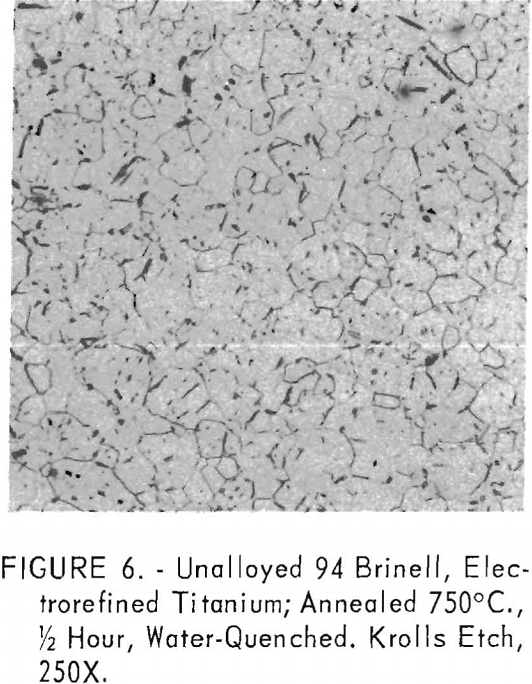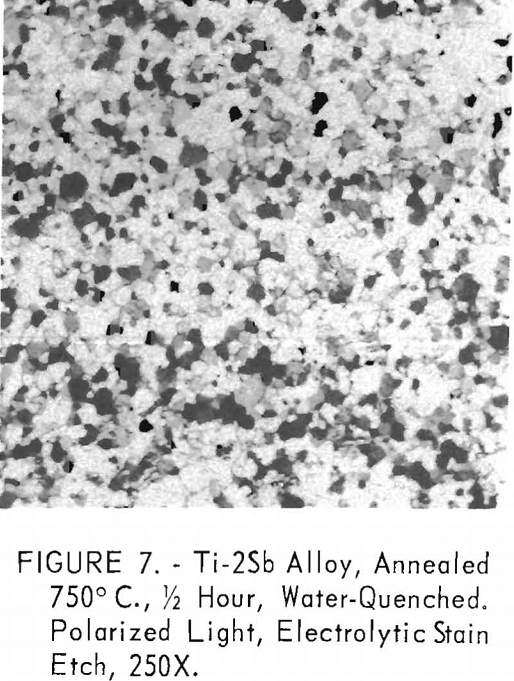Antimony up to 10 percent increases the strength of titanium by solid-solution hardening. The general relationship of hardness, strength, and elongation in these alloys is similar to that found in several grades of high-purity and commercial titanium.
Tensile strength (annealed condition) appeared to be a linear function of Vickers hardness regardless of composition.
For equivalent hardness and tensile strength, the antimony alloys showed a higher yield strength than unalloyed titanium without sacrificing ductility (elongation). The increase in yield strength was about 10 percent in a 5-percent antimony alloy at the 150-B.h.n. level.
Restriction of grain growth upon annealing is quite pronounced with 2 percent antimony or more and results in favorable combinations of yield strength and ductility.
The study described in this report was undertaken to obtain information on the character and effect of antimony additions to titanium. The availability of high-purity, low-hardness titanium metal, resulting from fused-salt electrorefining techniques, permitted a reassessment and evaluation of the physical behavior of titanium-antimony alloys.
Alloys, based on several grades of titanium containing up to 10 percent antimony, were arc-melted and processed to sheet by hot and cold rolling. Properties and characteristics were evaluated by hardness tests, hot and cold rollability, annealing treatments, metallographic examination, and tensile tests.
Antimony forms extensive solid solutions with titanium, resulting in the hardening and strengthening of the base metal. The general effect is similar to interstitial solutes and other impurities in commercial titanium. This report does not confirm improved ductility, which is claimed elsewhere; but, for the same hardness level, titanium-antimony alloys have adequate ductility and higher yield strengths than unalloyed titanium.
Very limited data on titanium-rich alloys of antimony are reported in the literature. Small amounts of antimony, up to 0.14 percent, did not effect the properties of titanium appreciably, and larger amounts were likely to vaporize in the alloy-preparation melting. McQuillan’s book entitled “Titanium” confirms the lack of information, other than references, on Ti-Sb, compounds. During the course of this investigation, patents became available describing the properties of both binary and ternary alloys of Ti with Sb. The addition of Sb was claimed to increase the strength considerably while retaining adequate ductility.
Alloys of this investigation were based on 70- and 94-B.h.n. electrorefined titanium, and 120-B.h.n. magnesium-reduced titanium. Physical behavior, including workability, recrystallization characteristics, and mechanical properties, was determined and forms the basis for comparison with published information.
Materials and Experimental Procedure
Alloys were prepared from 70- and 94-B.h.n. electrorefined titanium and 120-B.h.n. magnesium-reduced sponge. The electrorefined metal produced by fused-salt electrorefining techniques is characteristically crystalline, low in hardness, and contains minor amounts of impurities and interstitial contaminants. The 120-B.h.n. magnesium-reduced titanium represents commercial titanium sponge. Stick antimony, 99.9-percent purity, was utilized for all alloy additions. The analyses and hardness of the three grades of titanium are shown in table 1.

The alloys were double-melted in a tungsten-arc button-melting furnace under helium. The furnace was scavenged by melting titanium buttons before melting the alloys.
Arc-melted buttons were machined flat on both sides for Brinell hardness tests, after which they were cold rolled, wherever possible, directly to tensile specimen thickness (about 0.045 inch) without intermediate annealing.
The three series of alloys were annealed or solution-treated, as indicated by accompanying tables. Specimens for heat treatment were 0.5 by 0.5 by 0.045 inch; all treatments were conducted in either helium or vacuo.
Hardness values of sheet specimens reported in table 2 are the average of 6 readings on longitudinal sections prepared for metallography, using a Vickers hardness tester and a 10-kg. load.
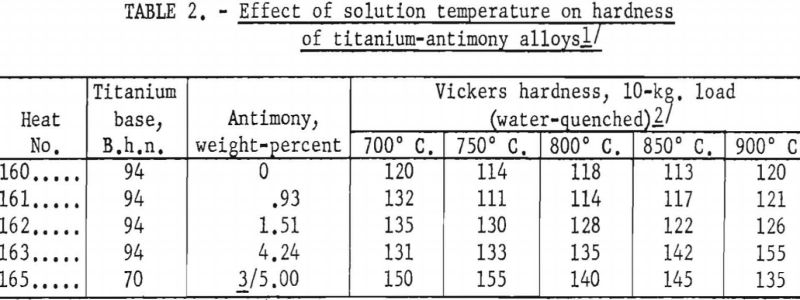
Tensile specimens, ½ inch wide with a 1-inch reduced section, were prepared with the long axis of specimen parallel to the direction of rolling. Tests were conducted at a loading rate of approximately 500 pounds per minute, and values reported in tables 3 and 4 represent an average of 3 to 5 tests.
Results and Discussion
Control buttons melted along with the alloy series indicated a nominal hardness increase of 3 or 4 Brinell units for 100-Brinell titanium. Considerable smoking and splattering occurred during melting and increased with antimony content. Maximum weight loss was about 8 percent for a 10-percent antimony alloy and 2 percent for unalloyed titanium. The 120-B.h.n. magnesium-reduced titanium-base alloys exhibited less spattering in melting; the maximum weight loss was about 3 percent. The major portion of weight loss was due to spatter or sputter of the alloy compacts rather than vaporization of antimony.


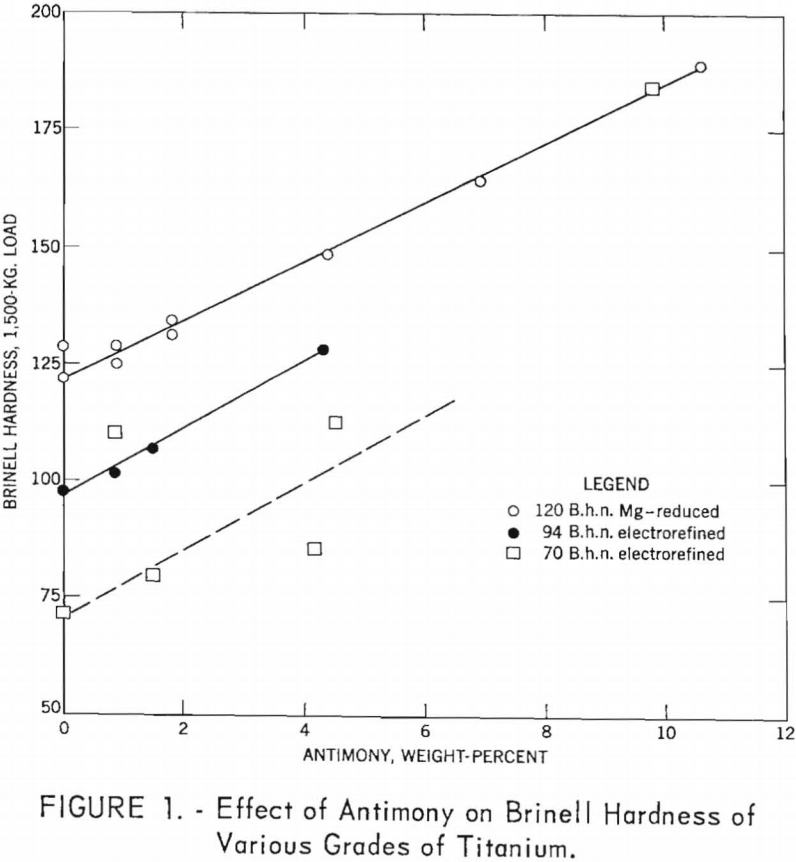
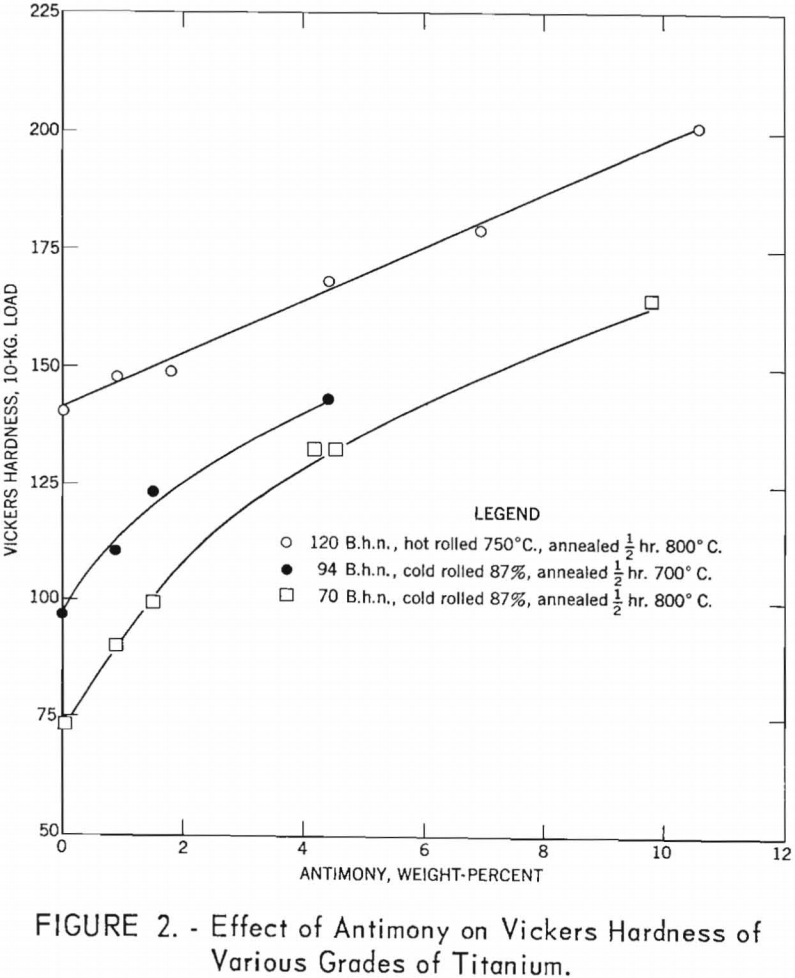
The cold-rolled alloys averaged 87-percent reduction, but several compositions failed at earlier stages. Failures were directly related to increasing antimony content and higher hardness of the titanium-base metal. With the 70-B.h.n titanium base, the 10-percent antimony alloy began to edge crack at about 75-percent reduction. The 94-B.h.n. base alloys began to crack badly at 25-percent reduction with 10 percent antimony. With the 120-B.h.n. titanium, even the 5-percent alloy began to crack badly at 55-percent reduction; therefore, a series of alloys based on 120-B.h.n. titanium was hot-rolled at 750° C followed by a light sandblast to remove the oxide surface.
The effect of antimony on the Brinell hardness of the as-melted alloys is shown in figure 1. The hardness of titanium-antimony alloys can be considered a linear function of antimony content. The data for alloys made with the lowest hardness titanium exhibit considerable variation in the as-cast condition, which is attributed to large and nonuniform grain structure and segregation. After rolling and annealing, the homogenized specimens showed higher and increasing hardness as the alloy content increased (fig. 2) . Solution treatment showed a slight but not entirely consistent trend in softening as the temperature increased (table 2). Aging treatments were not attempted.
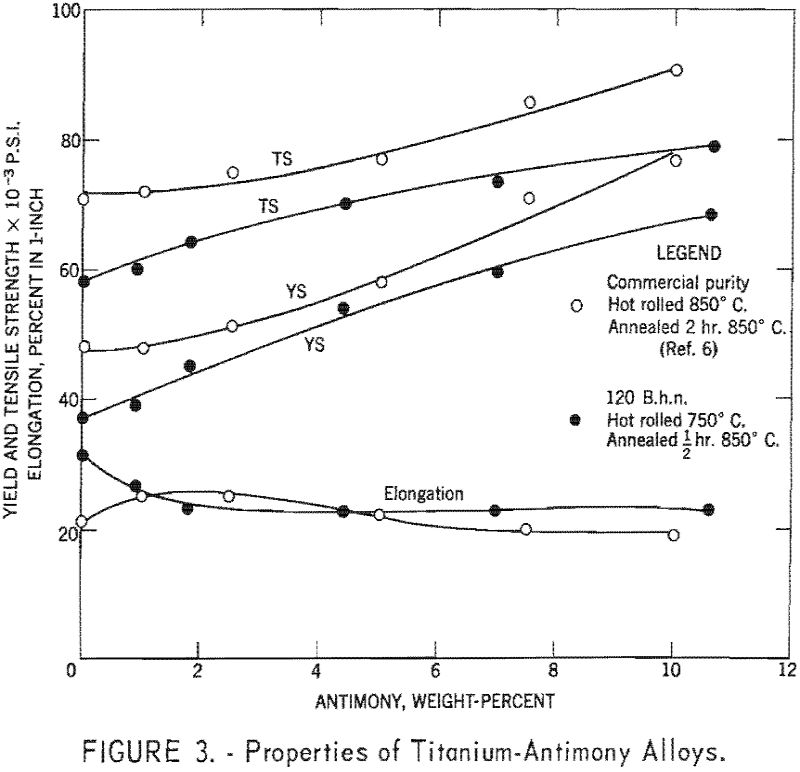
Strength properties as a function of antimony content are shown in figure 3 and tables 3 and 4. Comparing data of this investigation with that of Jaffe et al. reveals the significant and consistent effect of antimony on the tensile properties of titanium. Strength increases continuously up to 10 percent antimony. The metallographic evidence indicates only a continuous solid solution in this composition range. The atomic-size factor for antimony is plus-8.5 percent, and since both titanium and antimony have similar crystal structures, conditions are favorable for extended solid solubility according to the Hume-Rothery phase equilibra concepts.
The increasing hardness and strength and the decreasing ductility caused by antimony additions are related similarly to the property changes in titanium caused by oxygen and nitrogen, although far greater amounts of antimony are required to produce the same effect. It appears that for the same level of hardness, the tensile properties are quite similar, whether the strengthener is antimony or the normal impurities found in commercial titanium. There is consistent linear relationship of Vickers hardness versus tensile strength, regardless of antimony content or prior treatment. The yield strengths for antimony alloys, however, are higher than unalloyed titanium at the same hardness level. Furthermore, this gain in yield strength is not achieved at the expense of ductility.

The most pronounced change in properties caused by the antimony is evident in the yield strength and y.s.-t.s. ratio when the alloys are annealed at lower temperatures. The yield strength of 94-B.h.n. base titanium in the 700° C. annealed condition (fig. 4) can be more than doubled by the addition of 4 percent antimony. The increase in yield strength is much faster than the increase in tensile strength. This may be due to the combined effect of solid- solution hardening and restriction of grain growth by antimony at higher annealing temperatures. The rapid increase in the y.s.-t.s. ratio (0.47 to 0.78) coincides with the decrease in ducility (48 to 29 percent). At higher annealing temperatures and with 120-B.h.n.

titanium, the effect is not so pronounced, partly because the yield strength and y.s.-t.s. ratio of the harder titanium is higher initially.
Jaffee et al stress that antimony strengthens titanium without sacrificing ductility (elongation). This condition prevailed when alloys were based on relatively hard commercial-purity titanium that was hot-rolled and annealed. However, the effect was not as pronounced in cold-rolled and annealed alloys that were based on the softer, electrorefined titanium.
The rapid-grain growth in unalloyed electrorefined titanium with increasing annealing temperature is shown by the upper curve in figure 5. Correspondingly, the 2- and 5- percent antimony contents are strongly restrictive of grain growth up to 840° C. Equivalent grain sizes were noted for all compositions annealed at 900° C. The microstructures associated with this trend are shown in figures 6 to 12. Structures of the alloys above 1 percent antimony could be more clearly revealed by an electrolytic stain etch than by the conventional Kroll etch.
The banded structures and contrasting grain shadings observed under polarized light are similar to recrystallization phenomena noted for highly cold-worked zirconium where each band is believed to consist of a large number of similarly orientated grains.
